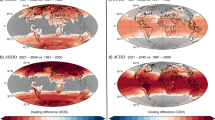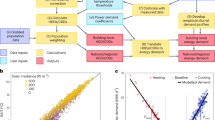Abstract
How climate change might impact energy demand is not well understood, yet energy forecasting requires that assumptions be specified. This paper reviews the literature on the relationship between global warming and the demand for space cooling in buildings. It then estimates two key parameters that link energy for space cooling to cooling degree days (CDDs) using data for nine U.S. Census divisions, which is the spatial resolution of the National Energy Modeling System (NEMS). The first parameter is the set point temperature for calculating CDDs; the second is the exponent for representing the relationship between changes in CDDs and changes in electricity consumption for space cooling. We find that the best-fitting CDDs have a set point of 67 °F (19.4 °C), for both residential and commercial buildings, rather than the conventional 65 °F (18.3 °C). Set points also vary by region, with warmer regions tending to have higher set points. When CDDs are based on the conventional set point, the best fitting exponent is 1.5 for both residential and commercial buildings, indicating that space cooling is more climate-sensitive than is specified in NEMS. As a result, the official projections of U.S. energy consumption would appear to underestimate the energy required for space cooling.



Similar content being viewed by others
Notes
NOAA’s National Climatic Data Center (NCDC) http://www.ncdc.noaa.gov/
Personal communications with Dr. Roderick Jackson (ORNL).
References
Akpinar-Ferrand E, Singh A (2010) Modeling increased demand of energy for air conditioners and consequent CO2 emissions to minimize health risks due to climate change in India. Environ Sci Pol 13(8):702–712
Amato AD, Ruth M, Kirshen P, Horwitz J (2005) Regional energy demand responses to climate change: methodology and application to the commonwealth of Massachusetts. Clim Chang 71(1–2):175–201
Apadula F, Bassini A, Elli A, Scapin S (2012) Relationships between meteorological variables and monthly electricity demand. Appl Energy 98:346–356
Argonne National Laboratory (ANL) (2008) Climate Change Impacts on the Electric Power System in the Western United States. Argonne
Auffhammer M, Aroonruengsawat A (2011) Simulating the impacts of climate change, prices and population on California’s Residential Electricity Consumption. Clim Chang 109(S1):191–210
Auffhammer M, Mansur E T (2012) Measuring climatic impacts on energy expenditures: a review of the empirical literature
Bessec M, Fouquau J (2008) The non-linear link between electricity consumption and temperature in Europe: a threshold panel approach. Energy Econ 30(5):2705–2721
Brown MA (2010) The multiple policy dimensions of carbon management: mitigation, adaptation, and geo-engineering. Carbon Manag 1(1):27–33
Brown MA, Cox M, Staver B, Baer P (2014) Climate Change and Energy Demand in Buildings. Proceedings of the American Council for an Energy Efficient Economy (ACEEE) Summer Study on Energy Efficiency in Buildings. Pacific Grove
Day T (2006) Degree-days: theory and application. The Chartered Institution of Building Services Engineers, London, p 106
Day AR, Jones PG, Maidment GG (2009) Forecasting future cooling demand in London. Energy Build 41(9):942–948
Dell J, Tierney S, Franco G, Newell RG, Richels R, Weyant J, Wilbanks TJ (2014) Ch. 4: Energy Supply and Use. In: Melillo JM, Richmond T (T C), Yohe GW (eds) Climate Change Impacts in the United States: The Third National Climate Assessment. U.S. Global Change Research Program
Deschênes O, Greenstone M (2011) Climate change, mortality, and adaptation: evidence from annual fluctuations in weather in the US. Am Econ J: Appl Econ 3(4):152–185
EIA (2005) Impacts of Temperature Variation on Energy Demand in Buildings. Issues in Focus, AEO2005
EIA (2009) Residential Energy Consumption Survey. Consumption and Efficiency. Retrieved from http://www.eia.gov/consumption/residential/
EIA (2013) Air Conditioning in Nearly 100 Million Homes. Retrieved from http://www.eia.gov/consumption/residential/reports/2009/air-conditioning.cfm
EIA (2014) Annual Energy Outlook 2014, Report DOE/EIA-0383(2014). U.S. Energy Information Administration (EIA), Washington D.C
Engle RF, Granger CWJ, Rice J, Weiss A (1986) Semiparametric estimates of the relation between weather and electricity. J Am Stat Assoc 81(394):310–320
Executive Office of the President (2013) Economic Benefits of Increasing Electric Grid Resilience To Weather Outages
Franco G, Sanstad AH (2008) Climate change and electricity demand in California. Clim Chang 87(S1):139–151. doi:10.1007/s10584-007-9364-y
Gupta E (2012) Global warming and electricity demand in the rapidly growing city of Delhi: a semi-parametric variable coefficient approach. Energy Econ 34(5):1407–1421
Hadley SW, Erickson DJ, Hernandez JL, Broniak CT, Blasing TJ (2006) Responses of energy use to climate change: a climate modeling study. Geophys Res Lett 33(17):L17703
Hamlet AF, Lee S-Y, Mickelson KEB, Elsner MM (2010) Effects of projected climate change on energy supply and demand in the Pacific Northwest and Washington State. Clim Chang 102(1–2):103–128
Hekkenberg M, Moll HC, Uiterkamp AJMS (2009) Dynamic temperature dependence patterns in future energy demand models in the context of climate change. Energy 34(11):1797–1806
Henley A, Peirson J (1997) Non-linearities in electricity demand and temperature: parametric versus non-parametric methods. Oxf Bull Econ Stat 59(1):149–162
Henley A, Peirson J (1998) Residential energy demand and the interaction of price and temperature: British experimental evidence. Energy Econ 20(2):157–171
Isaac M, Van Vuuren DP (2009) Modeling global residential sector energy demand for heating and air conditioning in the context of climate change. Energy Policy 37(2):507–521
Intergovernmental Panel on Climate Change (2014) Climate Change 2013: The Physical Science Basis
Mansur ET, Mendelsohn R, Morrison W (2008) Climate change adaptation: a study of fuel choice and consumption in the US energy sector. J Environ Econ Manag 55(2):175–193
McFarland, Zhou Y, Clarke L, Sullivan P, Colman J, Jaglom WS, Colley M, Patel P, Eom J, Kim SH, Page Kyle G, Schultz P, Venkatesh B, Haydel J, Mack C, Creason J (2015) Impacts of rising air temperatures and emissions mitigation on electricity demand and supply in the United States: a multi-model comparison. Clim Chang 131:111–125
Mirasgedis S, Sarafidis Y, Georgopoulou E, Lalas D, Moschovits M, Karagiannis F, Papakonstantinou D (2006) Models for mid-term electricity demand forecasting incorporating weather influences. Energy 31(2–3):208–227
Oak Ridge National Laboratory (ORNL) (2012) Climate Change and Infrastructure, Urban Systems, and Vulnerabilities. Oak Ridge, Tennessee
Sailor DJ (2001) Relating residential and commercial sector electricity loads to climate—evaluating state level sensitivities and vulnerabilities. Energy 26(7):645–657
Sailor DJ, Muñoz JR (1997) Sensitivity of electricity and natural Gas consumption to climate in the USA - methodology and results for eight states. Energy 22(10):987–998
Sailor D, Pavlova A (2003) Air conditioning market saturation and long-term response of residential cooling energy demand to climate change. Energy 28(9):941–951
Sathaye JA, Dale LL, Larsen PH, Fitts GA, Koy K, Lewis SM, De Lucena AFP (2013) Estimating impacts of warming temperatures on California’s electricity system. Glob Environ Chang 23(2):499–511
Scott MJ, Wrench LE, Hadley DL (1994) Effects of climate change on commercial building energy demand. Energy Sources 16(3):317–332
Shipworth M (2011) Thermostat settings in english houses: no evidence of change between 1984 and 2007. Build Environ 46(3):635–642
Shipworth M, Firth SK, Gentry MI, Wright AJ, Shipworth DT, Lomas KJ (2010) Central heating thermostat settings and timing: building demographics. Build Res Inf 38(1):50–69
Shorr N, Najjar RG, Amato A, Graham S (2009) Household heating and cooling energy use in the northeast USA: comparing the effects of climate change with those of purposive behaviors. Clim Res 39:19–30
Smith AM, Brown MA (2014) Policy considerations for adapting power systems to climate change. Electr J 27(9):112–125
Thornton BA, Cho H, Elliott DB, Halverson MA, Loper SA, Mendon V, Myer M, Richman EE (2013) Cost-effectiveness of ASHRAE Standard 90.1-2010 Compared to ASHRAE Standard 90.1-2007. Pacific Northwest National Laboratory, PNNL- 22043, Richland, Washington
U.S. Department of Energy (DOE) (2013) U.S. Energy Sector Vulnerabilities to Climate Change and Extreme Weather, Report DOE/PI-0013. DOE, Washington, DC
USGCRP (U.S. Global Change Research Program) (2009) In: Karl TR, Melillo JM, Peterson TC (eds) Global Climate Change Impacts in the United States. Cambridge University Press, Cambridge
Wilkerson JT, Cullenward D, Davidian D, Weyant JP (2013) End use technology choice in the national energy modeling systems (NEMS): an analysis of the residential and commercial building sectors. Energy Econ 40:773–784
Woods J (2006) Fiddling with Thermostats: Energy Implications of Heating and Cooling Set Point Behavior. 2006 ACEEE Summer Study on Buildings. pp. 278–287
Yun GY, Steemers K (2011) Behavioural, physical and socio-economic factors in household cooling energy consumption. Appl Energy 88(6):2191–2200
Acknowledgments
The authors gratefully acknowledge the research funding provided by Oak Ridge National Laboratory (contract number: 4000105765).
Author information
Authors and Affiliations
Corresponding author
Electronic supplementary material
Below is the link to the electronic supplementary material.
Table A.1
(DOCX 29 kb)
Rights and permissions
About this article
Cite this article
Brown, M.A., Cox, M., Staver, B. et al. Modeling climate-driven changes in U.S. buildings energy demand. Climatic Change 134, 29–44 (2016). https://doi.org/10.1007/s10584-015-1527-7
Received:
Accepted:
Published:
Issue Date:
DOI: https://doi.org/10.1007/s10584-015-1527-7




